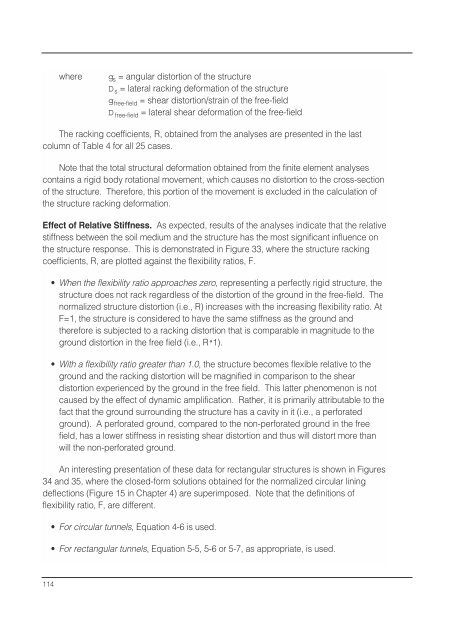Seismic Design of Tunnels - Parsons Brinckerhoff
Seismic Design of Tunnels - Parsons Brinckerhoff
Seismic Design of Tunnels - Parsons Brinckerhoff
You also want an ePaper? Increase the reach of your titles
YUMPU automatically turns print PDFs into web optimized ePapers that Google loves.
where<br />
g s = angular distortion <strong>of</strong> the structure<br />
D s = lateral racking deformation <strong>of</strong> the structure<br />
g free-field = shear distortion/strain <strong>of</strong> the free-field<br />
D free-field = lateral shear deformation <strong>of</strong> the free-field<br />
The racking coefficients, R, obtained from the analyses are presented in the last<br />
column <strong>of</strong> Table 4 for all 25 cases.<br />
Note that the total structural deformation obtained from the finite element analyses<br />
contains a rigid body rotational movement, which causes no distortion to the cross-section<br />
<strong>of</strong> the structure. Therefore, this portion <strong>of</strong> the movement is excluded in the calculation <strong>of</strong><br />
the structure racking deformation.<br />
Effect <strong>of</strong> Relative Stiffness. As expected, results <strong>of</strong> the analyses indicate that the relative<br />
stiffness between the soil medium and the structure has the most significant influence on<br />
the structure response. This is demonstrated in Figure 33, where the structure racking<br />
coefficients, R, are plotted against the flexibility ratios, F.<br />
• When the flexibility ratio approaches zero, representing a perfectly rigid structure, the<br />
structure does not rack regardless <strong>of</strong> the distortion <strong>of</strong> the ground in the free-field. The<br />
normalized structure distortion (i.e., R) increases with the increasing flexibility ratio. At<br />
F=1, the structure is considered to have the same stiffness as the ground and<br />
therefore is subjected to a racking distortion that is comparable in magnitude to the<br />
ground distortion in the free field (i.e., Rª1).<br />
• With a flexibility ratio greater than 1.0, the structure becomes flexible relative to the<br />
ground and the racking distortion will be magnified in comparison to the shear<br />
distortion experienced by the ground in the free field. This latter phenomenon is not<br />
caused by the effect <strong>of</strong> dynamic amplification. Rather, it is primarily attributable to the<br />
fact that the ground surrounding the structure has a cavity in it (i.e., a perforated<br />
ground). A perforated ground, compared to the non-perforated ground in the free<br />
field, has a lower stiffness in resisting shear distortion and thus will distort more than<br />
will the non-perforated ground.<br />
An interesting presentation <strong>of</strong> these data for rectangular structures is shown in Figures<br />
34 and 35, where the closed-form solutions obtained for the normalized circular lining<br />
deflections (Figure 15 in Chapter 4) are superimposed. Note that the definitions <strong>of</strong><br />
flexibility ratio, F, are different.<br />
• For circular tunnels, Equation 4-6 is used.<br />
• For rectangular tunnels, Equation 5-5, 5-6 or 5-7, as appropriate, is used.<br />
114
















